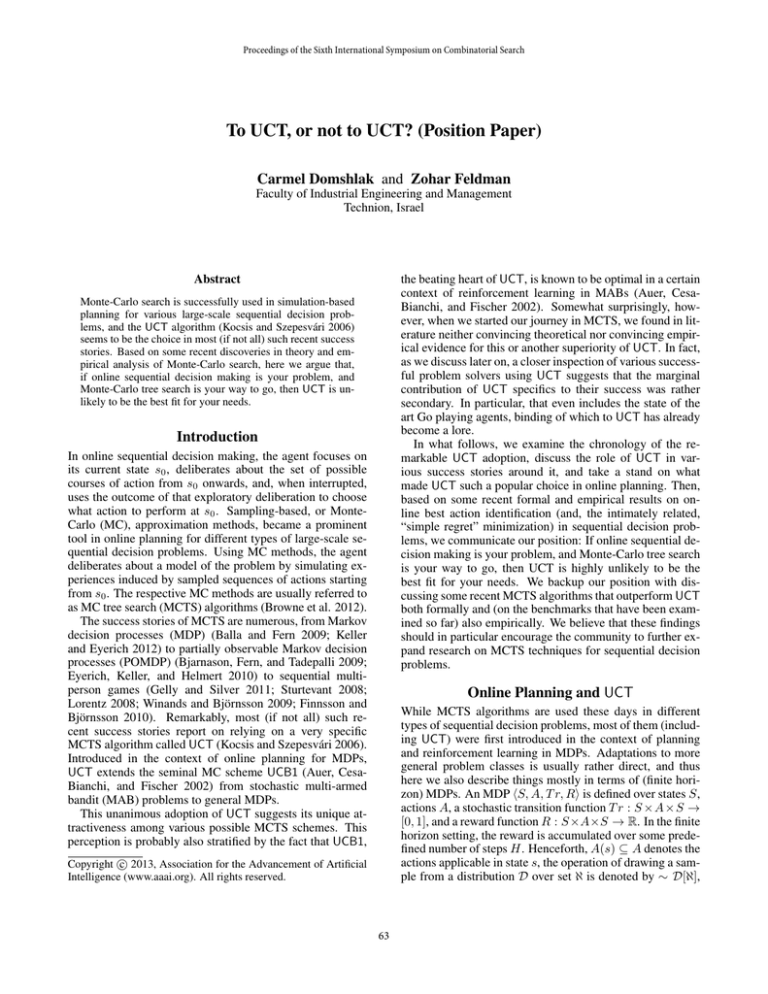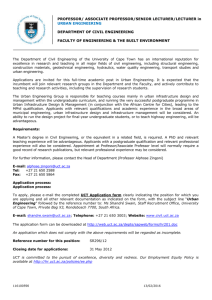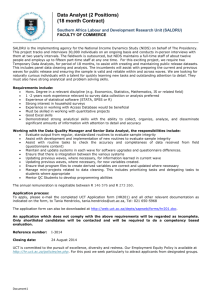
Proceedings of the Sixth International Symposium on Combinatorial Search
To UCT, or not to UCT? (Position Paper)
Carmel Domshlak and Zohar Feldman
Faculty of Industrial Engineering and Management
Technion, Israel
the beating heart of UCT, is known to be optimal in a certain
context of reinforcement learning in MABs (Auer, CesaBianchi, and Fischer 2002). Somewhat surprisingly, however, when we started our journey in MCTS, we found in literature neither convincing theoretical nor convincing empirical evidence for this or another superiority of UCT. In fact,
as we discuss later on, a closer inspection of various successful problem solvers using UCT suggests that the marginal
contribution of UCT specifics to their success was rather
secondary. In particular, that even includes the state of the
art Go playing agents, binding of which to UCT has already
become a lore.
In what follows, we examine the chronology of the remarkable UCT adoption, discuss the role of UCT in various success stories around it, and take a stand on what
made UCT such a popular choice in online planning. Then,
based on some recent formal and empirical results on online best action identification (and, the intimately related,
“simple regret” minimization) in sequential decision problems, we communicate our position: If online sequential decision making is your problem, and Monte-Carlo tree search
is your way to go, then UCT is highly unlikely to be the
best fit for your needs. We backup our position with discussing some recent MCTS algorithms that outperform UCT
both formally and (on the benchmarks that have been examined so far) also empirically. We believe that these findings
should in particular encourage the community to further expand research on MCTS techniques for sequential decision
problems.
Abstract
Monte-Carlo search is successfully used in simulation-based
planning for various large-scale sequential decision problems, and the UCT algorithm (Kocsis and Szepesvári 2006)
seems to be the choice in most (if not all) such recent success
stories. Based on some recent discoveries in theory and empirical analysis of Monte-Carlo search, here we argue that,
if online sequential decision making is your problem, and
Monte-Carlo tree search is your way to go, then UCT is unlikely to be the best fit for your needs.
Introduction
In online sequential decision making, the agent focuses on
its current state s0 , deliberates about the set of possible
courses of action from s0 onwards, and, when interrupted,
uses the outcome of that exploratory deliberation to choose
what action to perform at s0 . Sampling-based, or MonteCarlo (MC), approximation methods, became a prominent
tool in online planning for different types of large-scale sequential decision problems. Using MC methods, the agent
deliberates about a model of the problem by simulating experiences induced by sampled sequences of actions starting
from s0 . The respective MC methods are usually referred to
as MC tree search (MCTS) algorithms (Browne et al. 2012).
The success stories of MCTS are numerous, from Markov
decision processes (MDP) (Balla and Fern 2009; Keller
and Eyerich 2012) to partially observable Markov decision
processes (POMDP) (Bjarnason, Fern, and Tadepalli 2009;
Eyerich, Keller, and Helmert 2010) to sequential multiperson games (Gelly and Silver 2011; Sturtevant 2008;
Lorentz 2008; Winands and Björnsson 2009; Finnsson and
Björnsson 2010). Remarkably, most (if not all) such recent success stories report on relying on a very specific
MCTS algorithm called UCT (Kocsis and Szepesvári 2006).
Introduced in the context of online planning for MDPs,
UCT extends the seminal MC scheme UCB1 (Auer, CesaBianchi, and Fischer 2002) from stochastic multi-armed
bandit (MAB) problems to general MDPs.
This unanimous adoption of UCT suggests its unique attractiveness among various possible MCTS schemes. This
perception is probably also stratified by the fact that UCB1,
Online Planning and UCT
While MCTS algorithms are used these days in different
types of sequential decision problems, most of them (including UCT) were first introduced in the context of planning
and reinforcement learning in MDPs. Adaptations to more
general problem classes is usually rather direct, and thus
here we also describe things mostly in terms of (finite horizon) MDPs. An MDP hS, A, T r, Ri is defined over states S,
actions A, a stochastic transition function T r : S ×A×S →
[0, 1], and a reward function R : S×A×S → R. In the finite
horizon setting, the reward is accumulated over some predefined number of steps H. Henceforth, A(s) ⊆ A denotes the
actions applicable in state s, the operation of drawing a sample from a distribution D over set ℵ is denoted by ∼ D[ℵ],
c 2013, Association for the Advancement of Artificial
Copyright Intelligence (www.aaai.org). All rights reserved.
63
U denotes uniform distribution, and JnK for n ∈ N denotes
the set {1, . . . , n}.
2002). In resource-contract setting, the setup is reversed: the
algorithm is given a budget of computation units (e.g., time)
and it should aim at achieving within that budget the best action recommendation possible. In planning for MDPs, there
is a very close connection between these two contract setups (Even-Dar, Mannor, and Mansour 2002).
In contrast, in the interruptible setting, the planning time
is not known in advance, and when interrupted, the algorithm is required to provide a recommendation in time O(1).
In principle, any resource-contract algorithm can be compiled into an interruptible algorithm with only a constant
factor loss in recommendation quality for any interruption
point (Theorem 4.1 of Zilbershtein (1993)), the resulting interruptible algorithm will improve the quality of its recommendation only in time steps that are typically unacceptably
large.2 Hence, interruptibility in practice is a de facto synonym to continuous, smooth improvement of the recommendation quality over time.
In terms of this algorithm taxonomy, by online planning algorithms here we refer to algorithms that do not
rely on prior domain knowledge, aim at simple regret minimization, and converge in a sound and smooth way. This
type of MCTS algorithms seems to dominate applications
of MCTS in sequential decision processes, with UCT (as
we discuss below) being the most popular such algorithm
these days. Finally, we note that MCTS is clearly not
the only way to go when it comes to sequential decision processes (Powell 2011; Mausam and Kolobov 2012;
Bonet and Geffner 2012; Kolobov, Mausam, and Weld 2012;
Busoniu and Munos 2012). However, non-MCTS methods
are not in the scope of our discussion here.
Setup/Algorithm Taxonomy
Our focus here is on online MCTS planning. The notion
of “online planning”, however, is somewhat ill-defined, and
thus here we explicitly specify and justify the axes along
which we distinguish between various MCTS algorithms,
and, in these terms, what type(s) of algorithms are of our
interest.
Prior knowledge. In many works, the very notion of
onlineness corresponds to “no prior (explicit or learned)
knowledge of state/action value is required”. That is, while
online algorithms can possibly exploit such a prior knowledge, they remain well-defined even if no such prior knowledge is available, and their key formal properties (whatever
they are) stand steel.
Objective. When it comes to action recommendation,
different algorithms may focus on different notions of action quality. Most often, the quality of the action a, chosen for state s with H steps-to-go, is assessed in terms
of the probability that a is sub-optimal, or in terms of
the (closely related) measure of simple regret. The latter captures the performance loss that results from taking
a and then following an optimal policy π ∗ for the remaining H − 1 steps, instead of following π ∗ from the beginning (Bubeck and Munos 2010). Here we focus on
algorithms that aim at optimizing simple regret, but note
that other (e.g., risk related) planning objectives have also
been motivated and studied in control theory (Sobel 1982;
Mannor and Tsitsiklis 2011).
Soundness of convergence. If the action-choice error
probability goes to zero as a function of the computational
effort, then we say that the algorithm is sound.1 For instance, offline, feature-based learning of action values (such
as, e.g., variants of temporal difference learning (Sutton
1988)), are very popular in the context of sequential decision
processes (Buro 1999; Schaeffer, Hlynka, and Jussila 2001;
Gelly and Silver 2007). However, such offline learning algorithms can be sound only subject to representability of the
value function in the feature space in use, which in general
cannot be efficiently verified, and most typically does not
hold. That, in particular, gave rise to considering online action value assessment.
Smoothness of convergence. In terms of the planning
setup, we should distinguish between guarantee-contract,
resource-contract, and interruptible algorithms for MDP
planning (Zilbershtein 1993). A guarantee-contract algorithm is posed a guarantee requirement on the quality of the
recommended action, and it should aim at achieving the required guarantee as fast as possible. For instance, the wellstudied PAC bounds (, δ) correspond to guaranteeing a simple regret of at most with probability of at least δ (Kearns,
Mansour, and Ng 1999; Even-Dar, Mannor, and Mansour
The UCT Algorithm
MCTS, a canonical scheme underlying various MCTS algorithms for online MDP planning, is depicted in Figure 1a.
Starting with the current state s0 , MCTS performs an iterative construction of a tree3 T rooted at s0 . At each
iteration, MCTS rollouts a state-space sample ρ from s0 ,
which is then used to update T . First, each state/action pair
(s, a) is associated with a counter n(s, a) and a value acb a), both initialized to 0. When a sample
cumulator Q(s,
ρ is rolled out, for all states si ∈ ρ ∩ T , n(si , ai+1 ) and
b i , ai+1 ) are updated on the basis of ρ by the UPDATE Q(s
NODE procedure. Second, T can also be expanded with
any part of ρ; The standard choice is to expand T with
only the first state along ρ that is new to T (Coulom 2006;
Kocsis and Szepesvári 2006). In any case, once the sampling is interrupted, MCTS uses the information stored at
2
For MDPs, these steps do not have to grow exponentially with
time as in the general compilation scheme of Zilbershtein (1993).
However, the size of the step will still be of the order of the size
of the state space reachable from s0 in H steps. For all but very
simple MDPs, such steps are clearly of theoretical interest only.
3
In MDPs, there is no reason to distinguish between nodes associated with the same state at the same depth. Hence, the graph
T constructed by MCTS instances typically forms a DAG. Nevertheless, for consistency with prior literature, we stay with the term
“tree”.
1
While “converging” may seem a more natural name for this
property, it may also be somewhat misleading as some MCTS algorithm converge, but not necessarily to the right thing.
64
stochastic multi-armed bandit (MAB) environments (Robbins 1952). Adaptation of UCT to multi-person games
is straightforward (Sturtevant 2008); for instance, in twoperson zero-sum games, ROLLOUT- POLICY as in Figure 1
should simply be adapted to apply argmax and argmin at
the player’s and opponent’s turns, respectively. This is also
true for many other rollout schemes such ε-greedy, Boltzmann exploration, etc.
MCTS: [input: hS, A, T r, Ri; s0 ∈ S]
search tree T ← root node s0
for n ← 1 . . . time permits do
PROBE (s0 , 0)
b 0 , a)
return arg maxa Q(s
PROBE (s : state, d : depth)
if END - OF - PROBE(s, d) then
a ← ROLLOUT- POLICY(s)
return EVALUATE(s, d)
Adoption of UCT: A Closer Look
s0 ∼ P (S | s, a)
r ← R (s, a, s0 ) + PROBE(s0 , d + 1)
UPDATE - NODE (s, a, r)
return r
(a)
The initial adoption of UCT had been driven by advantages it offered comparatively to some other algorithms that
were used for sequential decision problems, such as offline feature-based learning, sparse sampling, non-sound interruptible MC algorithms such as flat MC, and primarily,
alpha-beta minimax search (Browne et al. 2012). In turn,
these successes created an information cascade, and many
recent works report on adopting UCT because it was widely
adopted already. But what are the specific properties of
UCT that have attracted so many practitioners across various
types of sequential decision problems, and was this attraction firmly justified? Considering a wide sample of works
on online MCTS planning, the arguments for adopting UCT
appear to be as follows.
Onlineness. Unlike the algorithms that UCT came to replace, UCT is a truly online planning algorithm in the sense
we defined above: it requires no prior domain knowledge,
the estimated values converge to the true (regular or minimax, depending on the setting) Q-values of the actions, and
the algorithm smoothly improves its estimates over time.
Together and separately, all these aspects of UCT’s onlineness are discussed in favor of UCT across the literature.
In the MAB setting, the UCB1 action-selection strategy
employed by UCT guarantees that the proportion of samples
devoted to the best action goes to 1 as the overall number of
samples goes to infinity. The claim of the UCT convergence
to the true action values relies precisely on (and only on) that
guarantee to carry on to MDPs. Yet, UCB1 is not unique in
that respect, as other strategies, such as ε-greedy action selection with time-adaptive value of ε (Auer, Cesa-Bianchi,
and Fischer 2002), also provide such a guarantee. Thus,
instances of MCTS that incorporate these action-selection
strategies with appropriate adjustments may very well be
proven sound as well.
What does single out UCB1 is that its soundness does not
depend on the choice of this or another set of control parameters that cannot be determined a priori, a quality that other
sound strategies lack. In other words, UCT offers not only
sound and smooth, but also parameter-free convergence of
action choice in MDPs/games. Somewhat surprisingly, however, we found no mention/discussion of this issue in the
literature, and this despite the clear practical value of that
uniqueness of UCT. Hence, while that property of UCT
could have explained the rapid adoption of this algorithm,
there must be something else responsible for the matter.
Favors more promising parts of the search tree. Following the UCB1 action selection policy at its rollouts, UCT
biases sampling and tree construction towards the actions
(s : state, d : depth)
if s 6∈ T then
add s to T and return true
else if d = H then return true else return false
END - OF - PROBE
(s : state, a: action, r : reward)
n (s, a) ← n (s, a) + 1
b
b a) ← Q(s,
b a) + r−Q(s,a)
Q(s,
n(s,a)
UPDATE - NODE
ROLLOUT- POLICY
(s : state)
if n(s, a) = 0 for some a ∈ A(s) then
return a ∼ U [{a ∈ A(s) | n(s, a) = 0}]
else
P
n(s) ← a∈A(s) n(s, a)
q
i
h
b a) + c log n(s)
return argmaxa Q(s,
n(s,a)
(s : state, d : depth)
for t ← d . . . H do
a ∼ U [A(s)]
s0 ∼ P (S | s, a)
r ← r + R (s, a, s0 )
s ← s0
return r
(b)
EVALUATE
Figure 1: (a) Monte-Carlo tree search template, and (b) the
UCT specifics.
the tree’s root to recommend an action to perform in s0 .
Concrete instances of MCTS vary mostly4 along the implementation of the ROLLOUT- POLICY sub-routine, that is,
in their policies for directing the rollout within T . Numerous concrete instances of MCTS have been proposed,
with UCT (Kocsis and Szepesvári 2006) apparently being
the most popular such instance these days. The specific
ROLLOUT- POLICY of UCT is shown in Figure 1b. This
policy is based on the deterministic decision rule UCB1
of Auer, Cesa-Bianchi, and Fischer (2002) for optimal balance between exploration and exploitation for cumulative
regret minimization in simultaneous acting and learning in
4
MCTS instances may also vary along the implementation of
However, it is hard to think of an implementation
other than that in Figure 1b, unless the algorithm is provided with
a problem-specific prior and/or heuristic.
EVALUATE .
65
postpone the issue of convergence rate to the next section,
and proceed with examining the empirical attractiveness of
UCT.
that are estimated at the moment to be of higher value. Together with the fact that UCB1 ensures that no action is ignored for good, this property of UCT is almost unanimously
accounted in favor of UCT (Gelly et al. 2006; Gelly and
Silver 2007; Lorentz 2008; Winands and Björnsson 2009;
Balla and Fern 2009). While at first view this asymmetry
of rollout dynamics seems to be appealing, this appeal was
never actually justified on a firm basis. Furthermore, certain
evidence suggested that the issue is not as straightforward as
it may look like.
Effective in practice. At the end of the day, what
probably matters the most is the empirical effectiveness
of planning. In that respect, it is most valuable to examine the reported experiences with UCT in the earlier
works that adopted this algorithm—as we already mentioned, more recent work seem to follow UCT adoption
simply because “it is known to work well”. Interestingly, a closer look reveals that UCT-based systems that
were truly successful in their domains were all using UCT
only in conjunction with some other, either ad hoc or
problem specific, tools for heuristic action value estimation such as rapid action value estimation (RAVE) (Gelly
and Silver 2007), first-play urgency (FPU) (Gelly et al.
2006), progressive bias (PB) (Winands and Björnsson 2009),
move-average sampling (MAST) (Finnsson and Björnsson
2008), predicate-average sampling (PAST) (Finnsson and
Björnsson 2010), features-to-action sampling (Finnsson and
Björnsson 2010), heuristic Q-value initialization (Keller and
Eyerich 2012), optimistic Q-value initialization (Eyerich,
Keller, and Helmert 2010), to name just a few5 .
More importantly, it appears that the value of using UCT
(and not some other MCTS scheme) in these systems is
rather marginal, and the key effectiveness actually comes
from the aforementioned auxiliary tools. For instance, in
their analysis of combining UCT with rapid action value estimation (RAVE) in MoGo, one of the strongest Go programs these days, Gelly and Silver (2007) write that “...
rapid action value estimate is worth about the same as several thousand episodes of UCT simulation.” In fact, later Silver (2009) writes that setting the bias parameter of UCB1 to
zero (that is, reducing it to greedy MCTS) is the best configuration of UCT in pair with RAVE in MoGo. Similar
in spirit observations on the crucial importance of heuristically guiding UCT have also been made in the context of
award-winning solvers for general game playing (Björnsson
and Finnsson 2009) and MDP planning (Keller and Eyerich
2012).
On the side of empirical experience, numerous works revealed high sensitivity of the UCT performance with respect
to the UCB1’s balancing parameter c, that is, sensitivity to
precisely that favoring of the search space regions that appear to be more attractive at the moment (Lorentz 2008;
Balla and Fern 2009; Gelly et al. 2006). In fact, in some
domains, extensive tuning revealed no single value for c that
works reasonably well across the state space (Balla and Fern
2009). Furthermore, right at the first days of applying UCT
in Go, Gelly et al. (2006) observed that “it is obvious that
the random variables involved in UCT are not identically
distributed nor independent. [...] the bias is amplified when
passing from deep level to the root, which prevents the algorithm from finding quickly the optimal arm at the root node”
[emphasis added]. Still, our formal understanding of UCT’s
convergence dynamics back then was rather preliminary, and
thus there was no clear argument against the seemingly appealing sampling asymmetry of the UCT’s rollout policy.
Effective in theory. It took few more years until some
first formal properties of UCB1 in the context of simple regret minimization have been revealed. First, Coquelin and
Munos (2007) showed that the number of samples after
which the bounds of UCT on simple regret become meaningful might be as high as hyper-exponential in the horizon
H. While these “bad news” are mostly of theoretical interest (since being online, UCT continuously improves its
estimates right from the first rollouts), having even a theoretical cold-start period of such a magnitude rings a bell.
Later on, Bubeck, Munos, and Stoltz (2011) showed in
the context of stochastic multi-armed bandits that sampling
with bias towards seemingly better actions may considerably slow down the reduction of simple regret over time. In
particular, Bubeck, Munos, and Stoltz (2011) showed that
UCB1 achieves only polynomial-rate reduction of simple regret over time, and this result immediately implies that the
simple regret reduction rate of UCT is at most polynomial
over time. Of course, that in itself does not mean that a
much better convergence rate can be achieved with any other
online MCTS algorithm. In fact, none of the MCTS instances suggested until very recently broke the barrier of the
worst-case polynomial-rate reduction of simple regret over
time. On the other hand, some of these alternative MCTS
instances, such as ε-greedy+UCT algorithm of Tolpin and
Shimony (2012) or a MAB-based enhancement of UCT proposed by Coquelin and Munos (2007), do provide somewhat better convergence rates for simple regret. At least,
that suggests that the speed of convergence does not constitute a unique attractiveness of UCT. For now, however, we
Online MCTS Better Than UCT?
In line with our findings above, Browne et al. (2012) summarize their survey on MCTS techniques by writing that,
“although basic implementations of MCTS provide effective play for some domains, results can be weak if the basic
algorithm is not enhanced.” Still, the relative effectiveness of
the basic MCTS algorithms does not seem to be systematically studied in the prior work. Thus, the way we see it, two
basic and important questions in the context of “to UCT or
not to UCT” remained open, notably
• Can the barrier of only polynomial-rate reduction of simple regret over time be removed in the context of online
MCTS algorithms?, and
5
For a comprehensive survey of such tools up to 2011, we refer
the reader to (Browne et al. 2012).
66
• Should UCT a priori be expected to be the most effective
basic online MCTS algorithm around?
MCTS2e: [input: hS, A, T r, Ri; s0 ∈ S]
search tree T ← root node s0 ; σ ← 0
for n ← 1 . . . time permits do
σ ← SWITCH - FUNCTION(n, σ)
PROBE (s0 , 0, σ)
b 0 , a)
return arg maxa Q(s
In what follows, we discuss some recent findings in theory
and empirical analysis of MCTS that provide a crisp answer
to the first of these questions, and a solid answer to the second one. In contrast to what seems to be a common belief
these days, these findings suggest that, if online sequential
decision making is your problem, and MCTS is your way to
go, then UCT is unlikely to be the best fit for your needs.
PROBE (s : state, d : depth, σ ∈ JHK)
if END - OF - PROBE(s, d) then return EVALUATE(s, d)
if d < σ then
a ← EXPLORATION - POLICY(s)
else
a ← ESTIMATION - POLICY(s)
s0 ∼ P (S | s, a)
r ← R (s, a, s0 ) + PROBE(s0 , d + 1, σ)
if d = σ then UPDATE - NODE(s, a, r)
return r
(a)
Exponential-rate convergence?
Bubeck, Munos, and Stoltz (2011) showed that an
exponential-rate reduction of simple regret over time is
achievable in stochastic multi-armed bandit (MAB) problems. The respective result is distribution-dependent, with
the dependency of the bounds on the arm reward distributions being reflected through the difference ∆ between the
expected rewards of the best and second-best arms. Since
then, the question of whether a similar rate of convergence
can be achieved for online MDP planning became even more
relevant than before, and recently we have provided an affirmative answer to this question (Feldman and Domshlak
2012).
The respective MCTS algorithm, BRUE, is an instance
of a non-standard MCTS scheme MCTS2e, a refinement of
MCTS that implements a principle of “separation of concerns”. According to that principle, different parts of each
sample are devoted exclusively either to search space exploration or to action value estimation. In MCTS2e (Figure 2a),
rollouts are generated by a two-phase process in which the
actions are selected according to an exploratory policy until
an (iteration-specific) switching point, and from that point
on, the actions are selected according to an estimation policy. A specific instance of MCTS2e, dubbed BRUE, was
shown to achieve an exponential-rate reduction of simple
regret over time, with the bounds on simple regret becoming meaningful after only exponential in H (in contrast to
UCT’s hyper-exponential in H) number of samples (Feldman and Domshlak 2012).
The specific MCTS2e sub-routines that define the BRUE
algorithm are shown in Figure 2b. Similarly to UCT, each
node/action pair (s, a) is associated with variables n(s, a)
b a), but with the latter being initialized to −∞.
and Q(s,
BRUE instantiates MCTS2e by choosing actions uniformly
at the exploration phase of the sample, choosing the best
empirical actions at the estimation phase, and changing the
switching point in a round-robin fashion over the entire
horizon. Importantly, if the switching point of a rollout
ρ = hs0 , a1 , s1 , . . . , aH , sH i is σ, then only the state/action
pair (sσ−1 , aσ ) is updated by the information collected by
ρ. That is, the information obtained by the estimation
phase of ρ is used only for improving the estimate at state
sσ(n)−1 , and is not pushed further up the sample. While
that may appear wasteful and counterintuitive, this locality of update is required to satisfy the formal guarantees of
BRUE on exponential-rate reduction of simple regret over
time (Feldman and Domshlak 2012). Practice-wise, we note
that BRUE is completely non-parametric, and thus neither
(s : state, d : depth)
if d = H then return true else return false
END - OF - PROBE
EVALUATE
(s : state, d : depth)
return 0
(s : state, a: action, r : reward)
if s 6∈ T then add s to T
n (s, a) ← n (s, a) + 1
b
b a) ← Q(s,
b a) + r−Q(s,a)
Q(s,
n(s,a)
UPDATE - NODE
(n : iteration, σ ∈ JHK)
return H − ((n − 1) mod H) // round robin on JHK
SWITCH - FUNCTION
EXPLORATION - POLICY
(s : state)
return a ∼ U [A(s)]
ESTIMATION - POLICY
h
(s : state)
i
b a)}
return a ∼ U {a | arg maxa∈A(s) Q(s,
(b)
Figure 2: Monte-Carlo tree search with “separation of concerns” (a), and the BRUE specifics (b).
its convergence nor its performance require any parameter
tuning.
Empirical performance?
While BRUE guarantees exponential-rate reduction of simple regret over time, it does not make special efforts to home
in on a reasonable alternative fast (Feldman and Domshlak
2012). Of course, “good” is often the best one can hope for
in large sequential decision problems of interest under practically reasonable planning-time allowance. Adopting the
principle of connected search tree expansion of the MCTS
instances, recently we came up with a simple modification
of BRUE, BRUEI , that performs as effectively under short
planning times as UCT and flat MC, while preserving both
the attractive formal properties of BRUE, as well as the empirical strength of the latter under permissive planning time
allowances (Feldman and Domshlak 2013). Furthermore,
67
0.65
2
2
MAB−Uniform
Flat MC
UCT
BRUE
BRUE
0.6
1.8
Flat
MC
MAB−Uniform
UCT
BRUE
BRUEIC
1.8
IC
0.55
BRUE
0.45
BRUEIC
0.4
0.35
0.3
0.25
1.6
1
2
3
4
5
6
7
Running Time (sec)
8
9
10
1.4
Average Error
UCT
Average Error
Average Error
1.6
MAB−Uniform
Flat MC
0.5
1.2
1.4
1.2
1
1
0.8
0.8
0
2
4
6
10×10
8
10
12
Running Time (sec)
14
20×20
16
18
20
0
10
20
30
40
50
60
Running Time (sec)
70
80
90
100
20×20 (zoom out)
Figure 3: Absolute performance of the algorithms in terms of average simple regret on the Sailing domain problems with 10×10
and 20×20 grid maps.
a more involved extension of BRUE, baptized as BRUEIC ,
is even more effectively, favorably competing with other
MCTS algorithms under short planning times in a robust
manner, while still preserving exponential-rate reduction of
simple regret over time. Inspired by certain insights provided by the surprising effectiveness of flat MC across IPC
domains, BRUEIC is based on selective tree expansion, conditioned on the information provided by a variant of flat MC
state-value estimation.
The technical details of the BRUEI and BRUEIC algorithms are less important for our discussion here, and for
these details we refer the reader to Feldman and Domshlak
(2013). In what follows, we only outline the key high-level
constructs of these two successive extensions of BRUE.
The only substantial difference between BRUE and
BRUEI is in what states are added to the search tree at each
rollout, and in the related SWITCH - FUNCTION procedure.
BRUE expands the search tree by the state at the switching
point of the rollout, and the switching point is changing between the iterations in a round-robin fashion over the entire
horizon. In contrast, BRUEI expands the search tree by the
shallowest state along the rollout up to the switching point
that is not yet in the tree, and if the tree expansion happens
not at the switching point, then the round-robin over switching points re-starts from the depth of one. This way, BRUEI
ensures connectedness of the search tree right from the first
iteration, while BRUE constructs it search tree by growing
a forest of its subtrees that gradually get connected into a
single tree. Note that the latter aspect of BRUE is not a bug
but a feature: in long term, this configuration of MCTS2e
ensures a higher rate of convergence to the optimal action
at the root. However, under severe restrictions on planning
time, BRUEI is expected to home in on a quality action
faster than BRUE, and this because it expedites backpropagation of values to the root. In any case, from some point on,
BRUEI behaves identically to BRUE, ensuring exponential
rate reduction of simple regret over time.
Building on top of BRUEI , BRUEIC is devoted to even
faster acquisition of a good alternative at the root via a notion of “selective tree expansion”. While the protocol for
selecting new states for the search tree in BRUEIC is similar
to this in BRUEI , the candidate states are added to the tree
only if their predecessors pass a certain test. Until a leaf state
s in the tree passes that test, its value V (s) is estimated via
the expected total reward of a policy sampled uniformly at
random, that is, in a manner that closely resembles the basic
(in principle, not sound) flat MC. Once the test is passed, the
successors of s are allowed to be added to the tree, and the
Q-values of actions at s are estimated as in BRUE. To ensure that all the desired convergence properties are satisfied,
the specific test used by BRUEIC to condition expansion of
the search tree ensures that no leaf is placed on hold for too
long.
At first view, not expanding the selected tree leaf and
putting it “on hold” may appear counterintuitive. However,
it is not all that simple. First, while each tree leaf can be seen
as sampling a single random variable, each internal node has
to sample b random variables, where b is the number of actions applicable at a state. Thus, the estimates of the random
variables sampled at the leaves converge much faster than
the estimates of the random variables sampled at the internal nodes. Second, while random variables estimated at an
internal node s aim at representing Q-values of the actions
at s, that is, the quantities of our actual interest, the quality of these estimates totally depends on the quality of the
information that is backpropagated from the descendants of
s. Hence, at certain stages of online planning, a slower estimation of the right thing can be less valuable than a faster
estimation of its approximation. Of course, the cruder the
approximation is, the eagerer we are to expand the node, and
vice versa, and this is precisely what the selective expansion
test of BRUEIC is devised to assess.
In (Feldman and Domshlak 2013) we examined the simple regret reduction of BRUE and BRUEIC under varying
time budgets, using the experimental settings of Feldman
and Domshlak (2012) for Sailing domain (Péret and Garcia 2004). Figure 3 plots the simple regret of the actions
recommended by flat MC, UCT, BRUE, and BRUEIC under different planning time windows, averaged over 300 instances of 10 × 10 and 20 × 20 grids. Importantly, no
domain-specific heuristics have been employed—the algorithms were tested in their pure form.6 First, these results
show that BRUE is continually improving towards an op6
68
That, in particular, explains the difference between the UCT’s
form UCT empirically, on numerous standard benchmarks.
The journey, of course, remains brand open: There is no reason to believe that either BRUE, or BRUEIC , or even their
backbone MCTS scheme MCTS2e, constitute the last word
in effectiveness of basic MCTS algorithms for online planning. However, they do show that, even the most agreed
upon, practices of MCTS-based planning should be questioned and investigated. In sum, we believe that further rigorous investigation of online MCTS planning is likely to be
both interesting and fruitful.
timal solution, rather quickly obtaining results better than
UCT (Feldman and Domshlak 2012). However, as it is
somewhat expected from the dynamics of the value backpropagation in UCT and BRUE, UCT sometimes manages
to identify reasonably good actions rather quickly, while
BRUE is still “warming up”. This is not so with BRUEIC .
Figure 3 shows that, not only does BRUEIC significantly
outperforms UCT uniformly over time, right from the beginning of planning, but also that its simple regret reduction
rate is comparable to BRUE’s in the longer term. Finally, at
least on this specific domain, there appears to be no substantial difference between the performance of flat MC and this
of UCT within the tested planning time allowances.
We also conducted a comparative evaluation of the same
set of algorithms on five MDP benchmarks from the last
International Probabilistic Planning Competition (IPPC2011), namely Game-of-Life, SysAdmin, Traffic, Crossing, and Navigation (Feldman and Domshlak 2013). These
benchmarks appear ideal for our purpose of evaluating algorithms under tight time constraints: Most IPPC-2011 domains induce very large branching factors, and thus allow
only a very shallow sampling of the underlying search tree
in reasonable time. The average-over-horizon planning time
was set to just five seconds. In sum, the results of this evaluation (Feldman and Domshlak, 2013—Table 1 and Figure
6) show that BRUEIC exhibits a robustly good performance
across the domains, finishing top performer on all the domains, and in fact, on most problem instances across the domains. Interestingly, similarly to what we observed in Sailing domain, the overall score of flat MC on the five domains
used in the evaluation was roughly the same as of UCT,
while adopting BRUEIC does make a difference.
Acknowledgements This work was partially supported by
the EOARD grant FA8655-12-1-2096, and the ISF grant
1045/12.
References
Auer, P.; Cesa-Bianchi, N.; and Fischer, P. 2002. Finitetime analysis of the multiarmed bandit problem. Machine
Learning 47(2-3):235–256.
Balla, R., and Fern, A. 2009. UCT for tactical assault planning in real-time strategy games. In IJCAI, 40–45.
Bjarnason, R.; Fern, A.; and Tadepalli, P. 2009. Lower
bounding Klondike Solitaire with Monte-Carlo planning. In
ICAPS.
Björnsson, Y., and Finnsson, H. 2009. CadiaPlayer: A
simulation-based general game player. IEEE Trans. on
Comp. Intell. and AI in Games 1(1):4–15.
Bonet, B., and Geffner, H. 2012. Action selection for MDPs:
Anytime AO∗ vs. UCT. In AAAI.
Browne, C.; Powley, E. J.; Whitehouse, D.; Lucas, S. M.;
Cowling, P. I.; Rohlfshagen, P.; Tavener, S.; Perez, D.;
Samothrakis, S.; and Colton, S. 2012. A survey of MonteCarlo tree search methods. IEEE Trans. on Comp. Intell.
and AI in Games 143.
Bubeck, S., and Munos, R. 2010. Open loop optimistic
planning. In COLT, 477–489.
Bubeck, S.; Munos, R.; and Stoltz, G. 2011. Pure exploration in finitely-armed and continuous-armed bandits.
Theor. Comput. Sci. 412(19):1832–1852.
Buro, M. 1999. From simple features to sophisticated evaluation functions. In ICCG, 126145.
Busoniu, L., and Munos, R. 2012. Optimistic planning
for Markov decision processes. In AISTATS, number 22 in
JMLR (Proceedings Track), 182–189.
Coquelin, P.-A., and Munos, R. 2007. Bandit algorithms
for tree search. In Proceedings of the 23rd Conference on
Uncertainty in Artificial Intelligence (UAI), 67–74.
Coulom, R. 2006. Efficient selectivity and backup operators
in Monte-Carlo tree search. In ICCG, 7283.
Even-Dar, E.; Mannor, S.; and Mansour, Y. 2002. PAC
bounds for multi-armed bandit and Markov decision processes. In COLT, 255–270.
Eyerich, P.; Keller, T.; and Helmert, M. 2010. High-quality
policies for the Canadian Traveler’s problem. In AAAI.
Summary
Summarizing the major emerging research directions around
MCTS, Browne et al. (2012) call for improving the performance of general-purpose MCTS, as well as for improving
our understanding of the behavior of various MCTS algorithms. In the current practice of online action planning with
MCTS, the UCT algorithm seems to be the choice of most,
domain-specific and domain-independent, solvers for various sequential decision problems. However, the question of
why UCT should in fact be preferred to other online MCTS
schemes remained largely unanswered.
Taking a closer look at the trail of developments that resulted in such a strong vote for UCT these days, we questioned both the rational behind this choice of platform for
MCTS problem solvers, as well as a common perception that
UCT is formally and/or empirically the best generic thing to
do. In particular, we discuss some recent results on MCTS,
and in particular, the BRUE and BRUEIC algorithms, that
both break the barrier of polynomial-rate convergence to the
optimal choice over time, as well as substantially outperperformance on the Sailing domain we report here, in Figure 3,
and the one reported in the original paper on UCT (Kocsis and
Szepesvári 2006): In the latter case, UCT was run with a strong
domain-specific heuristic that estimated state values within error
of at most 10%.
69
Feldman, Z., and Domshlak, C. 2012. Simple regret optimization in online planning for markov decision processes.
CoRR arXiv:1206.3382v2 [cs.AI].
Feldman, Z., and Domshlak, C. 2013. Monte-Carlo planning: Theoretically fast convergence meets practical efficiency. In UAI.
Finnsson, H., and Björnsson, Y. 2008. Simulation-based
approach to general game playing. In AAAI, 259264.
Finnsson, H., and Björnsson, Y. 2010. Learning simulation
control in general game-playing agents. In AAAI.
Gelly, S., and Silver, D. 2007. Combining online and offline
knowledge in UCT. In ICML, 273–280.
Gelly, S., and Silver, D. 2011. Monte-Carlo tree search
and rapid action value estimation in computer Go. AIJ
175(11):1856–1875.
Gelly, S.; Wang, Y.; Munos, R.; and Teytaud, O. 2006. Modication of UCT with patterns in Monte-Carlo Go. Technical
Report 6062, INRIA.
Kearns, M. J.; Mansour, Y.; and Ng, A. Y. 1999. A
sparse sampling algorithm for near-optimal planning in large
Markov decision processes. In IJCAI, 1324–1231.
Keller, T., and Eyerich, P. 2012. PROST: Probabilistic planning based on UCT. In ICAPS, 119–127.
Kocsis, L., and Szepesvári, C. 2006. Bandit based MonteCarlo planning. In ECML, 282–293.
Kolobov, A.; Mausam; and Weld, D. 2012. LRTDP vs. UCT
for online probabilistic planning. In AAAI.
Lorentz, R. 2008. Amazons discover Monte-Carlo. In
ICCG, 1324.
Mannor, S., and Tsitsiklis, J. N. 2011. Mean-variance optimization in Markov decision processes. In ICML, 177–184.
Mausam, and Kolobov, A. 2012. Planning with Markov
Decision Processes: An AI Perspective. Synthesis Lectures
on Artificial Intelligence and Machine Learning. Morgan &
Claypool.
Péret, L., and Garcia, F. 2004. On-line search for solving
Markov decision processes via heuristic sampling. In ECAI,
530–534.
Powell, W. B. 2011. Approximate Dynamic Programming:
Solving the Curses of Dimensionality. Wiley Series in Probability and Statistics. Wiley.
Robbins, H. 1952. Some aspects of the sequential design of
experiments. Bull. Amer. Math. Soc. 58(5):527535.
Schaeffer, J.; Hlynka, M.; and Jussila, V. 2001. Temporal difference learning applied to a high-performance gameplaying program. In IJCAI, 529–534.
Silver, D. 2009. Reinforcement Learning and SimulationBased Search in Computer Go. Ph.D. Dissertation, University of Alberta, Canada.
Sobel, M. J. 1982. The variance of discounted Markov decision processes. J. App. Probability 794–802.
Sturtevant, N. 2008. An analysis of UCT in multi-player
games. In CCG, 3749.
Sutton, R. 1988. Learning to predict by the method of temporal differences. ML 3:9–44.
Tolpin, D., and Shimony, S. E. 2012. MCTS based on simple
regret. In AAAI.
Winands, M., and Björnsson, Y. 2009. Evaluation function
based Monte-Carlo LOA. In ACG, 33–44.
Zilbershtein, S. 1993. Operational Rationality through
Compilation of Anytime Algorithms. Ph.D. Dissertation,
University of California at Berkeley.
70









